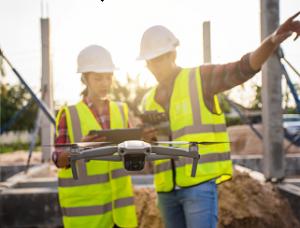
U.S. construction companies are working hard to meet the strong demands of domestic and global markets. One way they are addressing the increasing workloads is by adopting new technology. Using multi-faceted technologies gives companies the edge regarding safety, efficiency, and productivity. The right construction technology and software touch almost every part of a construction company’s work. Managers should research the latest tools to move forward with their current and prospective customers’ needs. Contact ITI Technical College today to learn how construction management technology is revolutionizing the construction field.
How Construction Management Technology Improves Safety
New construction technology makes the job site safer for anyone. On and offsite managers can use drones and mobile devices that make it easier to watch the job site. These ways to improve job site safety are welcomed by workers and visitors:
- Workers can report potential hazards and accidents sooner.
- Managers can deliver instructions to deal with hazards and accidents efficiently.
- Technology can give employees immediate and understandable warnings.
- Helmets become wearing technology with special lenses and augmented reality.
- Wearable tech can monitor how much time a person spends on jobs.
- New technology helps workers feel safer and safer.
Construction Management Technology Is Revolutionizing The Job Site
 Before we go on, It is important to note that technology is changing the job site. One example is using drones on a wide scale to ensure more precise surveying even from a remote location before construction begins. Drones and mobile devices make it easier to track what materials you need for each project and how much to order. This use saves companies a lot of money and reduces material waste.
Before we go on, It is important to note that technology is changing the job site. One example is using drones on a wide scale to ensure more precise surveying even from a remote location before construction begins. Drones and mobile devices make it easier to track what materials you need for each project and how much to order. This use saves companies a lot of money and reduces material waste.
Drones, new software, and digital devices connect job sites more effectively. You can check in with another job site to see if there are materials or equipment you need on another site. It can be sent over instead of ordering more. Drones can measure productivity and update clients on the progress of their projects. Updated drawings can be sent to clients and other stakeholders with these technologies.
Projects Are Brought To Life With Simulated Realities
Virtual reality shows how technology is changing the construction industry. Instead of presenting clients with 2D and 3D models, you can give them an immersive virtual reality (VR) experience. This technology enhances your design and planning for any project undertaken.
Augmented reality (AR) is more helpful on the job site than in the office. This technology can be used as wearable tech to help workers comprehend and avoid hazards and work smarter. It can be programmed to help employees perform simple and measurable tasks.
|
“One way they are addressing the increasing workloads is by adopting new technology.” |
How AI, Machine Learning, And Predictive Analytics Play Roles
 Many companies use artificial intelligence (AI) technology to improve their daily performance. Machine learning and predictive analytics help make them more efficient, productive, and safer. Here are some ways these concepts are used:
Many companies use artificial intelligence (AI) technology to improve their daily performance. Machine learning and predictive analytics help make them more efficient, productive, and safer. Here are some ways these concepts are used:
- Driverless vehicles move materials and equipment
- Technology can gather large amounts of data
- Predictive analytics helps managers see what can occur
- Predict when to order certain materials and when
- Identify issues on job sites and make corrective recommendations
Predictive analytics and machine learning can help companies locate and secure more jobs. It can improve safety and create better work schedules for employees and subcontractors.
Building Information Modeling (BIM) Technology
Building Information Modeling (BIM) is widely used today for private and government construction projects. It brings clarity and efficiency into construction projects and includes:
- Design – The design phase of construction requires conceptual design, analysis, and much documentation. BIM provides comprehensive modeling to organize construction and provide needed information about the design. It can ensure employees have access to the information, simplify scheduling, and communicate with logistics.
- Planning – Planning is made easier because this software can inform, guide, and simplify the work for construction managers. Users can use reality capture and real-world data to understand how homes and buildings will look before constructing them.
- Construction – Project specifications and shared documents are stored in the software that can guide and simplify construction through its phases.
- Operation – BIM stores data and information to support operations, maintenance, remodeling, ordering materials, and demolition.
- Ease of Use – BIM software is not difficult to learn and use because there are many tutorials available.
- Cost – Depending on the brand, software costs range from $120 to $335 for a monthly subscription.
Technology is revolutionizing the construction management field. Managers who use it effectively will be more productive and help their companies remain competitive. To learn more about a career in Construction Management, request more information from ITI Technical College, or visit our Construction Management (AOS) Associate In Occupational Studies Degree page.
.
For more information about graduation rates, the median debt of students who completed the program, and other important information, please visit our website:https://iticollege.edu/disclosures/



